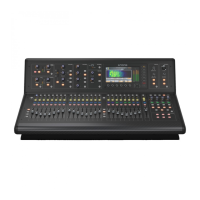4.6
Appendix F: Glossary
This glossary provides an explanation of the symbols, terms and abbreviations used in this manual.
5.1 surround:
A surround sound system created from six
channels that form a discrete signal, which is played back
over a speaker system comprising five speakers (three front
and two rear) and a subwoofer (which is the ‘.1’ or LFE
channel). See LFE.
μ:
Micro- prefix symbol that represents 10-6 or one millionth.
A
A/D:
Abbreviation for ‘analogue to digital’. The conversion of a
continuous signal into a numeric discrete sample sequence.
AC:
Abbreviation for ‘alternating current’.
AES/EBU:
Abbreviation for ‘Audio Engineering Society/European
Broadcasting Union’. See AES3.
Acoustic feedback:
A sound loop existing between an audio
input and audio output that is amplified on each cycle. For
example, a mic input signal is amplified and passed to a
loudspeaker. The output from the loudspeaker is
picked up the mic, which amplifies it again and passes it back to
the loudspeaker, and so on.
AES3:
Also known as ‘AES/EBU’, this is a serial interface for
transferring digital audio between devices.
AES50:
AES digital audio engineering standard. AES50 is a high
resolution, multi-channel audio interconnection (HRMAI).
Rather than a network, it is a high-performance, point-to-point
audio interconnection, although the auxiliary
data may operate as a true network, independently of the audio.
HRMAI provides a professional multi-channel audio interconnection
that uses Cat 5e data cable and is compatible with Ethernet
networks.
AFL:
Abbreviation for ‘after fader listen’. A function that allows
the signal to be monitored post-fader, that is, after it has been
acted upon by the fader.
Algorithm:
In computing, a set of instructions for accomplishing
a specific task.
amp (A):
Abbreviation for ‘ampere’. A unit of current.
Anti-aliasing:
When referring to digital images, a technique
that avoids poor pixelation.
Area A:
Primary input control area.
Area B:
A secondary input control area.
Assignable controls:
User-assignable controls that can be set up to
operate other functions.
Auto safe:
Prevents channel from accepting scene recall.
Auto-mute:
A function that automatically mutes the channel’s
signal under certain conditions.
Auto-mute group:
A function that automatically mutes a number
of selected channels under certain conditions.
Automation:
1. Memorization and playback of changes made to
mixer settings.
2. An area on the master bay that controls these.
Aux:
Abbreviation for ‘auxiliary send’ or ‘aux send’. A designation
for extra buses, typically used for sending signal to effects,
headphone amps and other destinations. See Bus.
Aux send:
See Aux.
B
Balanced audio:
A type of audio connection that uses the
three leads in a cable, connector and jack as part of a
phase-cancelling arrangement to boost the signal and
reduce noise.
Band:
In EQ, a range of frequencies.
Bandwidth:
In EQ, the width of a band, that is, the
number of frequencies that will be boosted/cut above
and below a centre frequency.

